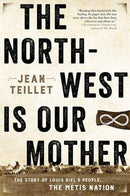Description
The North-West is Our Mother by Jean Teillet, great-grandniece of Louis Riel is the story of Louis Riel’s people, the Métis Nation of the Canadian North-West. The Métis Nation are a new Indigenous people descended from First Nations and Europeans and their narrative is missing as Indigenous peoples of Canada. This was first discussed in 1909 by the Old Wolves. Questions such as who are the Métis, what makes them a Nation, where they are, and their Indian ancestry are all answered in this book, which covers the period from the 1790s to 2018. During this time the Métis Nation have insisted on its existence as an Indigenous people and nation on the battlefield, in the courts and through negotiations for recognition, protection of their land and resources, and their existence with the development of Canada. Referencing their ancestors – Dumont, Lépine, Grant or Riel – places them in the Métis Nation’s historiography so defining its citizens, their Métis rights, Michif language, flag and political unity as a Nation. Their stories and their motherland define who is of the Métis Nation and who is not. The North-West is Our Mother has eight parts: The Birth of the Nation discusses Old Wolves, voyageurs, resistance, and victory at Frog Plain for example; Making the Nation includes the Iron Alliance and buffalo hunting the Métis Nation army and the Battle of Coteau; No Company’s Slave draws on resistance and court battles; The Red River Resistance; Early Life with Canada; The North-West Resistance as the fourth national resistance and La Guerre Nationale, after Batouche and the Trial of Louis Riel; Settlement; and, Renaissance covering the hunt for justice, Métis identity and freedom and infinity. There are five movements each defined by resistance against historical adversaries: Selkirk Settlers, the Hudson’s Bay Company, the Canadian Party, the Orange Lodge and the Canadian State. Includes maps, acknowledgements, notes to pages, bibliography, and index.


